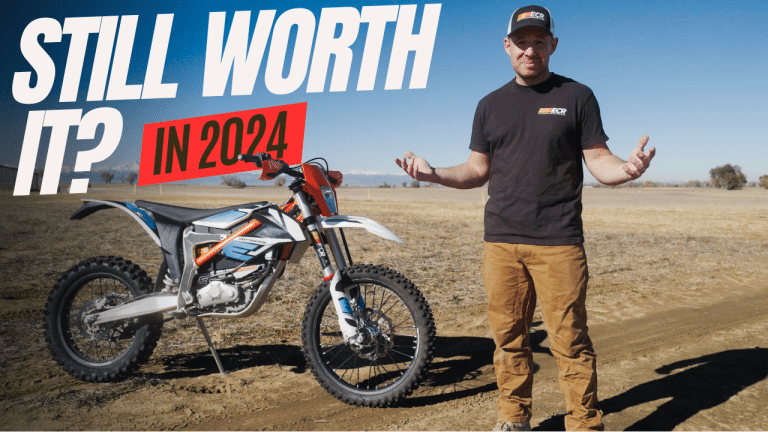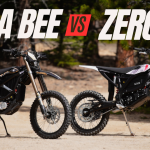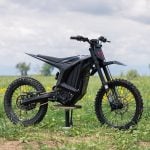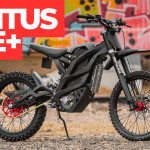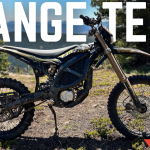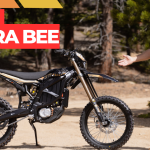In today’s rapidly evolving electric dirt bike scene, the choices are plentiful. Bikes like the Surron Ultra Bee have set new standards for cost competitive performance and bikes like the Stark Varg have set new benchmarks for performance. Even KTM (and Husqvarna) have refreshed their flagship electric model, the Freeride E (and Pioneer) to add another compelling option into the mix. But what about the original KTM Freeride E-XC? As secondhand prices drop, it begs the question: Is the KTM Freeride still worth it?
A Quick History of the KTM Freeride E-XC

KTM introduced the Freeride E-XC as a pilot program in the US in 2017 and followed up with a second generation in 2020. We’ll focus on the second gen here because these are way more abundant. The second-gen Freeride features:
2020-2024 KTM Freeride E-XC Specs
- 18 kW of peak power
- A swappable 260V, 3.9 kWh battery
- WP XPLOR 43mm front forks with 250mm of travel
- WP XPLOR PDS rear shock with 260mm of travel
- 21”/18” wheels
- FORMULA brakes
KTM Freeride E-XC Riding Impressions
The Freeride’s compact size makes it an ideal trail companion. While it lacks the raw power and top speed required for clearing jumps on most modern motocross tracks, it gets the job done in technical terrain and singletrack trails. Its manageable power, smooth delivery and slightly lower seat height make it especially appealing for riders looking for a vet friendly, easy to ride option in off road terrain.

However, there’s a catch: the weight. At 245 lbs, the Freeride straddles the line between mid-size and full-size bikes. Its lower seat height suggests a mid-size, but its weight places it firmly in big-bike territory. Despite this, as all electric dirt bikes do, the Freeride still feels light and agile on the trail thanks to the lack of rotating mass found in ICE engines.
KTM Reliability: A Hidden Strength
If there’s one thing the KTM Freeride has undoubtedly proven to us time and time again, its reliability. Over the years, it has been hands down the most dependable bike in the ECR fleet. Whether gas or electric, our test bikes are often in need of software updates, maintenance, or repairs. Meanwhile, the Freeride consistently seems to be ready to ride at a moment’s notice.
KTM Freeride E-XC Drawbacks
While the Freeride has plenty going for it, it’s not without its flaws. Here are the main pain points:
1. High Original MSRP
When it debuted, the Freeride carried a hefty price tag of over $11,000. For a bike with limitations in battery range and outright performance, this was a tough sell. However, with used models now available at significantly lower prices, this is less of a concern today.
2. Limited Battery Range
The Freeride’s range is modest, offering high teens to low 20s in miles per charge for aggressive riders. While a second battery can mitigate this issue, swapping batteries mid-ride isn’t always practical. On the bright side, the Freeride supports fast 220V charging, but this feature is less useful in the U.S., where 220V outlets are rare.
3. The 12V Battery Issue
The Freeride’s smaller 12V battery is mandatory for starting the bike but has a frustrating tendency to drain quickly. Worse, the bike doesn’t charge this battery during operation. Over the years, this has left us stranded more than a few times and has necessitated frequent replacements. Pro tip: Always keep a spare battery handy!
Freeride vs. Ultra Bee
A common question we hear is whether to opt for a discounted Freeride or a Surron Ultra Bee. The answer depends on your priorities:
- Battery Range: The Ultra Bee offers roughly 20% better battery life but slower charging times compared to the Freeride.
- Weight: The Ultra Bee is lighter, making it more nimble in most situations.
- Customization: The Ultra Bee’s aftermarket support is far superior, allowing for more extensive modifications. However, to match the Freeride’s trail capability, you’ll need to invest in upgrades like suspension, 21”/18” wheels, and other miscellaneous parts.
- Build Quality: The Freeride’s superior build quality and stock suspension are standout features, especially when compared to the Ultra Bee in its stock form.
Recommended Upgrades for the Freeride
To get the most out of the Freeride, consider these tried-and-true upgrades:
- Nihilo Big Brake Kit: Adapts a full-size rear brake for better stopping power.
- Tires: The IRC IX-09s are a great, versatile gummy tire choice for improved traction.
- Suspension: Race Tech Gold Valves and a Dal Soggio XP-One kit transform the suspension.
- Rear Brake Conversion: Swap the rear brake to a foot brake setup using OEM parts for a more traditional feel.

Should you Buy a KTM Freeride E-XC?
We think KTM Freeride EXC remains a solid option in 2024, especially at its current massively decreased price point. While it’s not without its quirks, the Freeride’s reliability, build quality, and trail performance make it a compelling choice for riders that ride close to a 220v charger source. Whether it’s still relevant depends on your priorities, but it’s safe to say this bike still has a lot to offer.

